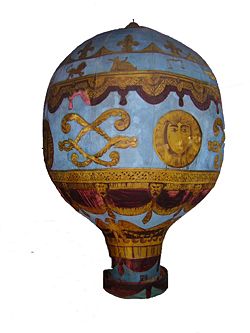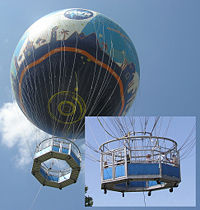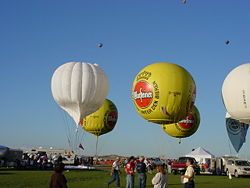A balloon is a flexible bag normally filled with a gas, such as helium, hydrogen, nitrous oxide or air. Some balloons are purely decorative, others are used for specific purposes. Early balloons were made of dried animal bladders. Modern balloons can be made from materials such as rubber, latex, chloroprene or a nylon fabric. The modern balloon was invented by Michael Faraday in the 1800s, but mass production did not occur until the 1930s. A balloon's unique properties including its low density and relative inexpensivness have lead to a wide range of applications.
As decoration or entertainment
Party balloons are mostly made of natural latex tapped from rubber trees and can be filled with air, helium, water, or any other suitable liquid or gas. The rubber allows for elasticity which makes the volume adjustable. Most of this rubber is made from recycled material, such as old tires and tennis shoes.
Filling with air is done with the mouth, with a manual or electric inflator (such as a hand pump) or a source of compressed air.
When rubber balloons are filled with helium so that they float they can hold their lift for only a short time depending on the size of the balloon, the time can vary from 18 hours to several days. The enclosed helium atoms escape through small pores in the latex which are larger than the helium atoms. Balloons filled with air can hold their size and shape much longer.
Even a perfect rubber membrane eventually loses the gas to the outside. The process by which a substance or solute migrates from a region of high concentration, through a barrier or membrane, to a region of lower concentration is called diffusion. The inside of balloons can be treated with a special gel (e.g., "Hi Float" brand) which coats the inside of the balloon to reduce the helium leakage, thus increasing float time to a week or longer. Latex rubber balloons are completely biodegradable.
Beginning in the late 1970s, some more expensive (and longer-lasting) foil balloons have been made of thin, unstretchable, less permeable metallized plastic films. These balloons have attractive shiny reflective surfaces and are often printed with color pictures and patterns for gifts and parties. The most important attributes of metallized nylon for balloons are its light weight, increasing buoyancy and its ability to keep the helium gas from escaping for several weeks. However, there has been some environmental concern, since the metallized nylon does not biodegrade or shred as a rubber balloon does, and a helium balloon released into the atmosphere can travel a long way before finally bursting or deflating. Release of these types of balloons into the atmosphere is considered harmful to the environment. This type of balloon can also conduct electricity on its surface and released foil balloons can become entangled in powerlines and cause power outages.
Released balloons can land almost anywhere, including on nature preserves or other areas where they pose a serious hazard to animals through ingestion or entanglement. Latex balloons are especially dangerous to sea creatures because latex retains its elasticity for 12 months or more when exposed to sea water rather than air.[1] Because of the harm to wildlife and the effect of litter on the environment, some jurisdictions even legislate to control mass balloon releases. Legislation proposed in Maryland, USA was named after Inky, a pygmy sperm whale who needed 6 operations after swallowing debris, the largest piece of which was a mylar balloon.[2][3]
Balloon artists are entertainers who twist and tie inflated tubular balloons into sculptures (see also balloon animal). The balloons used for balloon sculpture are made of extra-stretchy rubber so that they can be twisted and tied without bursting. Since the pressure required to inflate a balloon is inversely proportional to the diameter of the balloon, these tiny tubular balloons are extremely hard to inflate initially. A pump is usually used to inflate these balloons.
Decorators may use hundreds of helium balloons to create balloon sculptures. Usually the round shape of the balloon restricts these to simple arches or walls, but on occasion more ambitious "sculptures" have been attempted. It is also common to use balloons as tables decorations for celebratory events. Table decorations normally appear with 3 or 5 balloons on each bouquet. Ribbon is curled and added with a weight to keep the balloons from floating away.
Professional balloon party decorators use electronic equipment to enable the exact amount of helium to fill the balloon. For non-floating balloons air inflators are used. Professional quality balloons are used, these differ from most retail, packet balloons by being larger in size and made from 100 percent biodegradable latex.
Water balloons are thin, small rubber balloons intended to be easily broken. They are usually used by children, who throw them at each other, trying to get each other wet - see practical joke.
In the early 1980s, decorating for parties with balloons became easier with the introduction of Balloon Time helium balloon kits. Each kit comes with a set number of balloons, ribbon and a helium-filled tank allowing the user to fill up balloons quickly and pretty inexpensively. Kits typically cost anywhere from $20-$30.
See also: Balloon-carried light effect
As flying machines
Large balloons filled with hot air or buoyant gas have been used as flying machines since the eighteenth century. The earliest flights were made with hot air balloons that used either air or helium heated with a flame. These balloons traveled by moving with the wind. Later, airships were made that could be propelled through the air in a controlled manner. Airships often had a more rigid structure and were sealed and unheated; buoyancy was provided by using hydrogen or helium. The term aerostat is applied to a balloon that is moored to the ground rather than free flying.
Types of balloon aircraft
There are three main types of balloon aircraft:
- hot air balloons obtain their buoyancy by heating the air inside the balloon. They are the most common type of balloon aircraft.
- gas balloons are inflated with a gas of lower molecular weight than the ambient atmosphere. Most gas balloons operate with the internal pressure of the gas being the same as the surrounding atmosphere. There is a special type of gas balloon called superpressure balloons that can operate with the lifting gas at pressure that exceeds the pressure of the surrounding air with the objective of limiting or eliminating the loss of gas from day-time heating. Gas balloons are filled with gases such as:
- hydrogen - not widely used for aircraft since the Hindenburg disaster because of high flammability (except for some sport balloons as well as nearly all unmanned scientific and weather balloons).
- helium - the gas used today for all airships and most manned balloons in the United States
- ammonia - used infrequently due to its caustic qualities and limited lift
- coal gas - used in the early days of ballooning, high flammability
- Rozière balloons use both heated and unheated lifting gases. The most common modern use of this type of balloon is for long distance record flights such as the recent circumnavigations.
History
The hot air balloon was developed as a children's toy round about the second or third century C.E. in China.
It has been proposed that some ancient civilizations developed manned hot air balloon flight. For example it has been proposed that the Nazca lines (which are best seen from the air) presuppose some form of manned flight, and a balloon was the only possible available technology that could have achieved this. Julian Nott designed and built a balloon using woven cotton fabric and a Torta reed gondola, both readily available to the peoples who made the Nazca lines. Heating the air in the balloon with a wood fire, Nott flew over the Nazca Plains. He comments that there is no evidence of any kind that that ancient peoples did fly but this flight proved beyond doubt that most early civilizations could have flown: all they needed was a loom and fire.
In 1709 in Lisbon, Bartolomeu de Gusmão made a balloon filled with heated air rise inside a room. He also made a balloon named Passarola (Port. Big bird) and attempted to lift himself from Saint George Castle, in Lisbon, but only managed to harmlessly fall about one kilometre away.
Following Henry Cavendish's work on hydrogen, of 1766, Joseph Black proposed that a balloon filled with hydrogen would be able to rise in the air.

The first recorded manned balloon flight was made in a hot air balloon built by the Montgolfier brothers on November 21, 1783. The flight started in Paris and reached a height of 500 feet or so. The pilots, Jean-François Pilâtre de Rozier and Francois Laurent (the Marquis of d’ Arlanders) covered about 5 1/2 miles in 25 minutes.
Only a few days later, on December 1, 1783, Professor Jacques Charles and Nicholas Louis Robert made the first gas balloon flight. Like the first hot air balloon flight, this flight left from Paris. The hydrogen filled balloon flew to almost 2000 feet, stayed aloft for over two hours and covered a distance of 27 miles, landing in the small town of Nesle.
Once flight was shown to be possible, the next great challenge was to fly across the English Channel. The feat was accomplished on January 7, 1785 by Jean-Pierre Blanchard, a Frenchman, and American John Jeffries, who sponsored the flight.
The first aircraft disaster occurred in May 1785 when the town of Tullamore, Co. Offaly Ireland was seriously damaged when the crash of a balloon resulted in a fire that burned down about 100 houses giving the town the unusual distinction of being home to the world's first aviation disaster. To this day, the town shield depicts a phoenix rising from the ashes.
Blanchard went on to make the first manned flight of a balloon in America on January 9, 1793. His hydrogen filled balloon took off from a prison yard in Philadelphia, Pennsylvania. The flight reached 5,800 feet and landed in Gloucester County in New Jersey. George Washington was among the guests observing the take off.
Gas balloons became the most common type from the 1790s until the 1960s.
The first steerable balloon (also known as a dirigible) was attempted by Henri Giffard in 1852. Powered by a steam engine it was too slow to be effective. Like heavier than air flight, the internal combustion engine made dirigibles, especially blimps, practical, starting in the late nineteenth century.
Ed Yost reinvented the design of hot air balloons in the late 1950s using rip-stop nylon fabrics and high powered propane burners to create the modern hot air balloon. His first flight of such a balloon, lasting 25 minutes and covering 3 miles, occurred on October 22, 1960 in Bruning, Nebraska.
Yost's improved design for hot air balloons triggered the modern sport balloon movement. Today, hot air balloons are much more common than gas balloons.
Balloons as flying machines
A balloon is conceptually the simplest of all flying machines. The balloon is a fabric envelope filled with a gas that is lighter than the surrounding atmosphere. As the entire balloon is less dense than its surroundings, it rises, taking along with it a basket, attached underneath, that carries passengers or payload.
The first balloons capable of carrying passengers used hot air to obtain buoyancy and were built by the brothers Josef and Etienne Montgolfier in Annonay, France.
Balloons using the light gas hydrogen for buoyancy were flown less than a month later. They were invented by Professor Jacques Charles and first flown on December 1, 1783. Gas balloons have greater lift and can be flown much longer than hot air, so gas balloons dominated ballooning for the next 200 years. In the 19th century, it was common to use town gas to fill balloons; it was not as light as hydrogen gas, but was much cheaper and readily available.
The third balloon type was invented by Pilâtre de Rozier and is a hybrid of a hot air and a gas balloon. Gas balloons have an advantage of being able to fly for a long time and hot air balloons have an advantage of being able to easily change altitude so the Rozier balloon was a hydrogen balloon with a separate hot air balloon attached. In 1785, Pilâtre de Rozier took off in an attempt to fly across the English Channel but the balloon exploded a half-hour into the flight. This accident earned de Rozier the title "The First to Fly and the First to Die." It wasn't until the 1980s that technology once again allowed the Rozier balloons to become feasible.
Jean-Pierre Blanchard made the first piloted balloon flight in North America on January 9, 1793. Although a balloon has no propulsion system, a degree of directional control is possible through making the balloon rise or sink in altitude to find favorable wind directions.
Both the hot-air, or Montgolfière, balloon and the gas balloon are still in common use. Montgolfière balloons are relatively inexpensive as they do not require high-grade materials for their envelopes, and they are popular for balloonist sport activity.
Light gas balloons are predominant in scientific applications, as they are capable of reaching much higher altitudes for much longer periods of time. They are generally filled with helium. Although hydrogen has more lifting power, it is explosive in an atmosphere full of oxygen. With a few exceptions, scientific balloon missions are unmanned.
There are two types of light-gas balloons: zero-pressure and superpressure. Zero-pressure balloons are the traditional form of light-gas balloon. They are partially inflated with the light gas before launch, with the gas pressure the same both inside and outside the balloon. As the zero-pressure balloon rises, its gas expands to maintain the zero pressure difference, and the balloon's envelope swells.
At night, the gas in a zero-pressure balloon cools and contracts, causing the balloon to sink. A zero-pressure balloon can only maintain altitude by releasing gas when it goes too high, where the expanding gas can threaten to rupture the envelope, or releasing ballast when it sinks too low. Loss of gas and ballast limits the endurance of zero-pressure balloons to a few days.
A superpressure balloon, in contrast, has a tough and inelastic envelope that is filled with light gas to pressure higher than that of the external atmosphere, and then sealed. The superpressure balloon cannot change size greatly, and so maintains a generally constant volume. The superpressure balloon maintains an altitude of constant density in the atmosphere, and can maintain flight until gas leakage gradually brings it down.
Superpressure balloons offer flight endurance of months, rather than days. In fact, in typical operation an Earth-based superpressure balloon mission is ended by a command from ground control to open the envelope, rather than by natural leakage of gas.
For air transport balloons must contain a gas lighter than the surrounding air. There are two types:
- hot air balloons: filled with hot air, which by heating becomes lighter than the surrounding air; they have been used to carry human passengers since the 1790s;
- balloons filled with:
Large helium balloons are used as high flying vessels to carry scientific instruments (as do weather balloons), or even human passengers.
Cluster ballooning uses many smaller gas-filled balloons for flight (see An Introduction to Cluster Ballooning).
Balloons in the military
The first military use of a balloon was at the Battle of Fleurus in 1794, when L'Entreprenant was used by French Revolutionary troops to watch the movements of the enemy. On the April 2, 1794, an aeronauts corps was created in the French army; however, given the logistical problems linked with the production of hydrogen on the battlefield (it required constructing ovens and pouring water on white-hot iron), the corps was disbanded in 1799.
American Civil War
The first major-scale use of balloons in the military occurred during the American Civil War with the Union Army Balloon Corps established and organized by Prof. Thaddeus S. C. Lowe in the summer of 1861. The balloons were inflated with coke gas from municipal services and then walked out to the battlefield, an arduous and inefficient operation as the balloons had to be returned to the city every four days for re-inflation. Eventually hydrogen gas generators, a compact system of tanks and copper plumbing, were constructed which converted the combining of iron filings and sulphuric acid to hydrogen. The generators were easily transported with the uninflated balloons to the field on a standard buckboard. In all Lowe built seven balloons that were fit for military service.
The first application thought useful for balloons was map making from aerial vantage points, thus Lowe's first assignment was with the Topographical Engineers. General Irvin McDowell, commander of the Grand Army of the Potomac, realized their value in aerial reconnaissance and had Lowe, who at the time was using his personal balloon the Enterprise, called up to the First Battle of Bull Run. In a later exercise, Lowe was called to act as a Forward Artillery Observer (FAO) from which aerial station he was able to direct artillery fire by a set order of flag signals, from an unseen position, onto a Confederate encampment. FAO is still used today from either ground or aerial positions.
Lowe's first military balloon, the Eagle was ready by October 1st, 1861. It was called into service immediately to be towed to Lewinsville, Virginia, without any gas generator which took longer to build. The trip began after inflation in Washington and turned into a 12-mile, 12-hour excursion that was upended by a gale force wind which ripped the aerostat from its netting and sent it sailing to the coast. Balloon activities were suspended until all balloons and gas generators were completed
With his ability to inflate balloons from remote stations, Lowe, his new balloon the Washington and two gas generators were loaded onto a converted coal barge the George Washington Parke Custis. As he was towed down the Potomac, Lowe was able to ascend and observe the battlefield as it moved inward on the heavily forested peninsula. This would be the military's first claim of an aircraft carrier.
The Union Army Balloon Corps enjoyed more success in the battles of the Peninsula Campaign than the Army of the Potomac it sought to support. The general military attitude toward the use of balloons deteriorated, and by August 1863 the Balloon Corps was disbanded.
Confederate Army uses
The Confederate Army made use of balloons, but they were gravely hampered by supplies due to the embargoes. They were forced to fashion their balloons from gaily colored silk dress-making material, and their use was limited by the infrequent supply of gas in Richmond, Virginia. By the summer of 1863, all balloon reconnaissance of the Civil War had ceased.
In other countries
In Britain during July 1863 experimental balloon ascents for reconnaissance purposes were conducted by the Royal Engineers on behalf of the British Army, but although the experiments were successful it was considered not worth pursuing further because it was too expensive. However by 1888 a School of Ballooning was established at Chatham, Medway Kent. It moved to Stanhope Lines, Aldershot in 1890 when a balloon section and depot were formed as permanent units of the Royal Engineers establishment.
Balloons were used by the Royal Engineers for reconnaissance and observation purposes during the Bechuanaland Expedition (1885), the Sudan Expedition (1885) and during the Anglo Boer War (1899-1802). On 5 October 1907 Colonel John Capper (late Royal Engineers) and team flew the military airship Nulli Secundus from Farnborough round At Paul's Cathedral in London and back with a view to raising public interest.
Hydrogen-filled balloons were also widely used during World War I (1914-1918) to detect enemy troop movements and to direct artillery fire. Observers phoned their reports to officers on the ground who then relayed the information to those who needed it.
Because artillery was such an important factor in World War I, balloons were frequent targets of opposing aircraft. Though balloon companies were protected by antiaircraft guns and patrolling fighters, casualties were frequently heavy. One reason for this was the hydrogen that filled the balloons was highly flammable, and planes assigned to attack enemy balloons were often equipped with incendiary bullets, for the purpose of igniting the balloon.
The Aeronaut Badge was established by the United States Army in World War I to denote service members who were qualified balloon pilots. Observation balloons were retained well after the Great War, being used in the Russo-Finnish conflicts (1939-1940 and 1941-1945).
The Japanese launched thousands of balloon bombs to the US and Canada, carried in the jet stream; see fire balloons. The British used balloons to carry incendiary devices to Germany between 1942 and 1944, see Operation Outward.
In space
Balloons have a number of advantages for planetary exploration. They can be made light in weight and are potentially relatively inexpensive. They can cover a great deal of territory, and their view from a height gives them the ability to examine wide swathes of terrain with far more detail than would be available from an orbiting satellite. For exploratory missions, their relative lack of directional control is not a major obstacle as there is generally no need to direct them to a specific location.
In June 1985, the Russian space probes Vega 1 and Vega 2 each released an aerobot (balloon-like robot) into the atmosphere of Venus. Signals from the first balloon were received for only 56 minutes, but those from the second arrived for nearly two Earth days until its batteries ran down.
Balloons such as the Echo satellite are launched with a rocket. They are not the typical balloon, but simply large deployable structures.
In medicine
Angioplasty is a surgical procedure in which very small balloons are inserted into blocked or partially blocked blood vessels near the heart. Once in place, the balloon can be inflated to clear or compress arterial plaque, and to stretch the walls of the vein. A small stent can be inserted in its place to keep the vessel open after the balloon's removal. See myocardial infarction.
Certain catheters have balloons at their tip to keep them from slipping out, for example the balloon of a Foley catheter is insufflated when the catheter is inserted into the urinary bladder and secures its position.
Records
Manned Balloon
The altitude record for manned balloons is 34668 metres. It was made by Malcolm D. Ross and Victor E. Prather over the Gulf of Mexico in 1961.
Unmanned Balloon
The altitude record for unmanned balloons is (1991 edition of Guinness Book) 51.8 kilometres. The vehicle was a Winzen-Balloon with a volume of 1.35 million cubic metres, which was launched in October 1972 in Chico, California, USA. This is the greatest altitude ever reached by a flying object requiring the surrounding air. Higher altitudes can only be reached by ballistic vehicles such as rockets, rocket planes or projectiles.
See also
- Aerobot
- Atlas (rocket)
- Balloon-carried light effect
- Balloon mail
- Captive balloon
- Radiosonde
- Rockoon
- Speech balloon
- List of altitude records reached by different aircraft types
- List of balloon uses
- Airship
- Blimp
- Cluster ballooning
- First flying machine
- Gas balloon
- Fire balloon
- High altitude balloon
- Hopper balloon
- Hot air balloon
- List of early flying machines
- Montgolfier Brothers
- Project Manhigh
- QinetiQ 1
- Skyhook balloon
- Zeppelin
- Thermal airship
- List of altitude records reached by different aircraft types
- Observation balloon
Notes
- ↑ A.L. Andrady, 2006-08-06 "Plastics and Their Impacts in the Marine Environment." Proceedings of the International Marine Debris Conference on Derelict Fishing Gear and the Ocean Environment Hawaiian Islands Humpback Whale National Marine Sanctuary. Hawaii.[1] 140 accessdate 2006-12-02
- ↑ MARP Sponsors Inky Legislation [2]. Aquarium in Baltimore accessdate 2006-12-01
- ↑ [3] Legislation regulating the release of balloons. Clean Virginia Waterways accessdate 2006-12-01
ReferencesISBN links support NWE through referral fees
- Evans, Charles M. The War of the Aeronauts: The History of Ballooning in the Civil War. Mechanicsburg, PA: Stockpile Books, 2002. ISBN 0811713954
- Haydon, F. Stanbury; Crouch, Tom D. Military Ballooning during the Early Civil War. Baltimore, MD: The Johns Hopkins University Press, 2000. ISBN 0801864429
- Smith, Anthony. Balloning. Osceola, WI: Motorbooks International, 1999. ISBN 1852605685
External links
All links retrieved August 26, 2023.
Credits
New World Encyclopedia writers and editors rewrote and completed the Wikipedia article in accordance with New World Encyclopedia standards. This article abides by terms of the Creative Commons CC-by-sa 3.0 License (CC-by-sa), which may be used and disseminated with proper attribution. Credit is due under the terms of this license that can reference both the New World Encyclopedia contributors and the selfless volunteer contributors of the Wikimedia Foundation. To cite this article click here for a list of acceptable citing formats.The history of earlier contributions by wikipedians is accessible to researchers here:
The history of this article since it was imported to New World Encyclopedia:
Note: Some restrictions may apply to use of individual images which are separately licensed.






